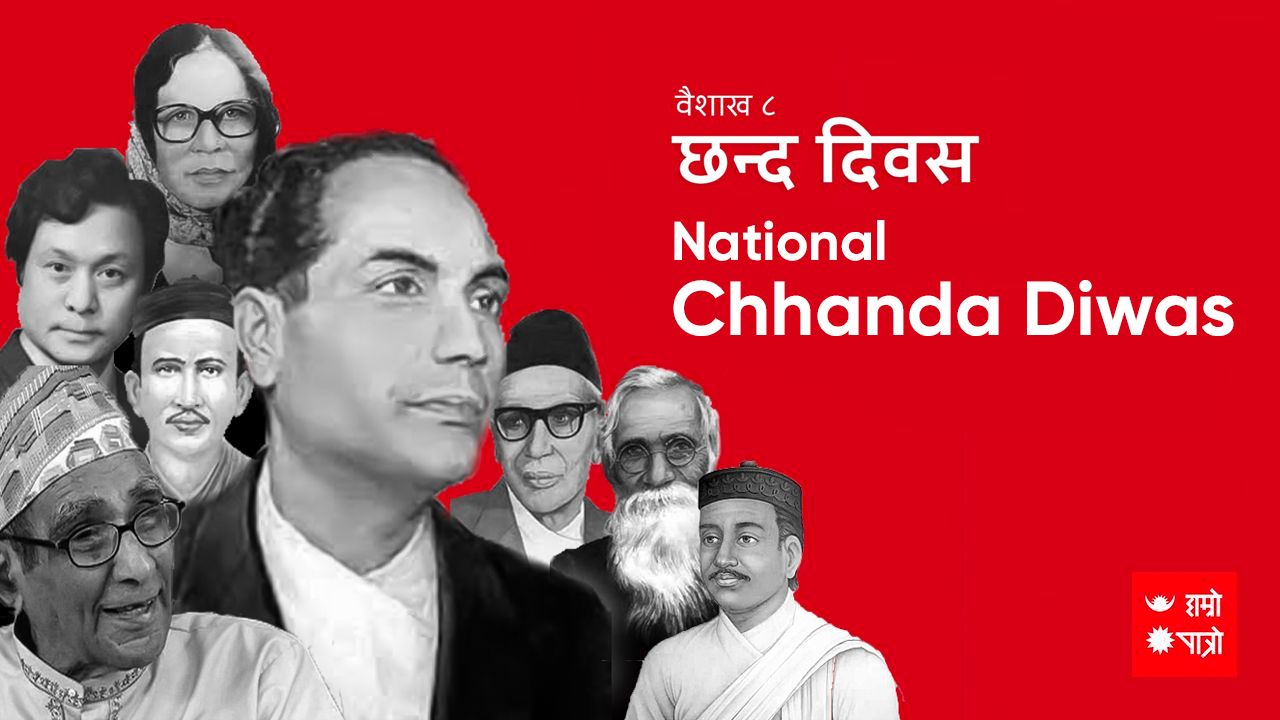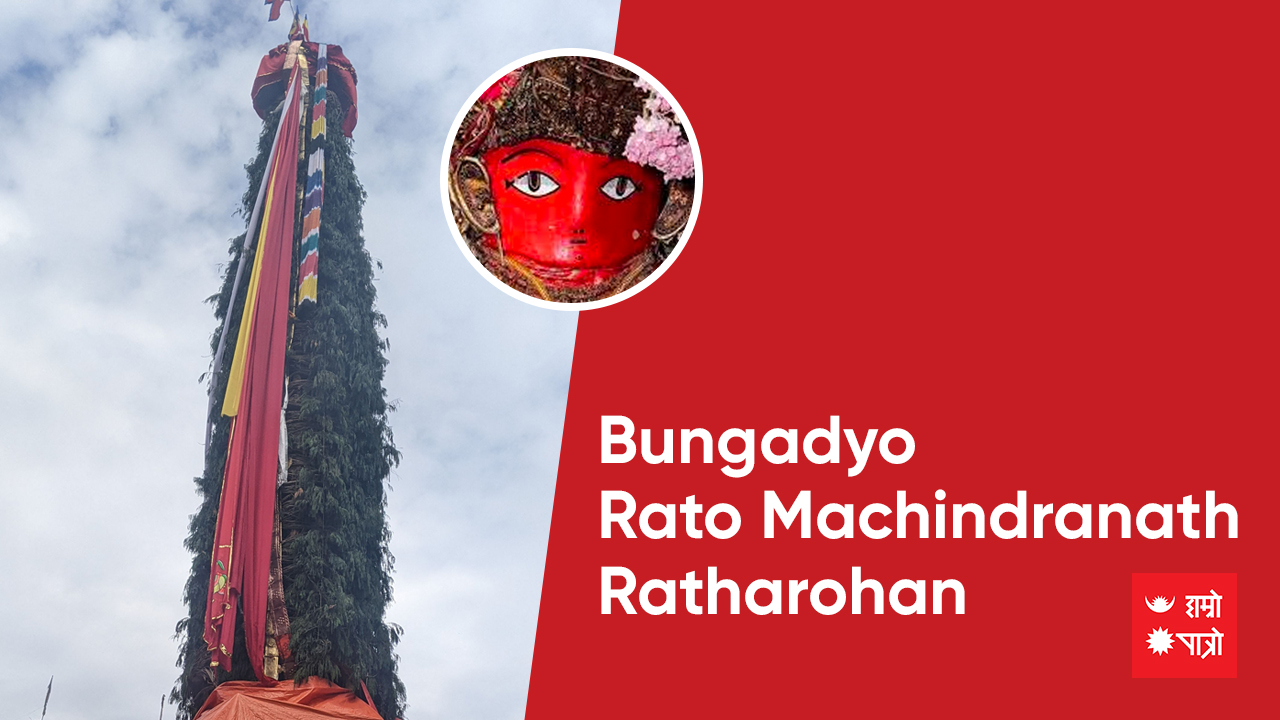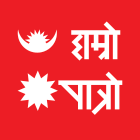Upcomming Events
-
30JesthaSithi Nakha/World Day Against Child Labour 2 days remaning
-
32JesthaGorakhkali Puja/World Blood Donor Day 4 days remaning
-
1AashadhaMithun Sankranti/World Elder Abuse Awareness Day 5 days remaning
-
2Aashadha
-
3Aashadha
-
4AashadhaNirjala Ekadashi Vrata (Vaisnav) 8 days remaning
-
5Aashadha
-
6AashadhaWorld Refugee Day 10 days remaning
-
7AashadhaPoornima Vrata/World Yoga Day/ Music Day 11 days remaning
-
8AashadhaJya: Punhi/Kabir Jayanti 12 days remaning
-
9AashadhaInternational Widows Day 13 days remaning
-
11AashadhaMangal Chauthi Vrata/Bhumi Pooja 15 days remaning
-
12AashadhaInternational Day against Drug Abuse and Illicit Trafficking 16 days remaning
-
15AashadhaDahi chiura Khane Din/ Rashtriya Dhan Diwas/Gorakhkali Puja 19 days remaning
-
18AashadhaYogini Ekadashi Vrata/World Sports Journalist Day 22 days remaning
-
19AashadhaPradosh Vrata 23 days remaning
-
22AashadhaInternational Cooperative Day 26 days remaning
-
27AashadhaWorld Population Day 31 days remaning
-
29AashadhaBhanu Jayanti/Surya Pooja 33 days remaning
-
30AashadhaGorakhkali Puja 34 days remaning
-
31AashadhaWorld Youth Skill Day 35 days remaning
-
1Shrawan
-
2ShrawanHarishayani Ekadashi Vrata/Chaturmaas Wrata Aarambha 37 days remaning
-
3ShrawanPradosh Vrata 38 days remaning
-
5ShrawanPoornima Vrata 40 days remaning
-
6ShrawanGuru Purnima Vrata/Vyas Jayanti 41 days remaning
-
11ShrawanVitak Katha Arambha 46 days remaning
-
13ShrawanWorld Hepatitis Day/Gorakhkali Puja 48 days remaning
-
14ShrawanWorld Tiger Day 49 days remaning
-
15Shrawan
-
16ShrawanKamika Ekadashi Vrata 51 days remaning
-
17ShrawanPradosh Vrata/World BreastFeeding Week 52 days remaning
-
18ShrawanGathamug Chahre 53 days remaning
-
21ShrawanGunla Parwa Arambha 56 days remaning
-
23ShrawanBaraah Jayanti 58 days remaning
-
24ShrawanInternational Soil Conservation Day 59 days remaning
-
25Shrawan
-
26ShrawanKalki Jayanti 61 days remaning
-
27ShrawanRavisaptami Vrata/Tulasidas Jayanti 62 days remaning
-
28ShrawanInternational Youth Day/Gorakhkali Puja 63 days remaning
Jyotish
-
Jyotish Khagendra Subediसम्पूर्णानंद संस्कृत विश्ववि...
-
Jyotish Narayan Prasad Dulalसम्पूर्णानन्द संस्कृत विश्वव...
-
Jyotish Ghanashyam Pokharelनेपाल संस्कृत विश्वविद्यालयब...
-
Jyotish Mukunda Sharmaस्वाध्याय, सत्सङ्ग र सदाचारजस�...
-
Jyotish Purushottam Ghimireनेपाल संस्कृत विश्वविद्यालय, �...
-
Jyotish Smarika Acharyaबाल्मीकि बिद्यापिठ बाट ज्योत�...
-
Jyotish Deepak Prasad Kafleसम्पूर्णानन्द संस्कृत विश्वव...
-
Hamro Patro JyotishI am test jyotish please donot call.
-
Jyotish Dr. Janak Bhattaविगत ३५ वर्षदेखि कुण्डली निर्�...
-
Jyotish Vaman Sapkotaशिक्षा - व्याकरणाचार्य, पौरोही...
-
Jyotish Mohan Ghimireसम्पुर्णानन्द संस्कृत विश्वव...
-
Acharya Choodamani Pathakसम्पूर्णानन्दसंस्कृत विश्वव�...
-
Jyotish Narayan Prasad Gautamगुरुकुल शिक्षा प्रणालीबाट ज्�...
-
Jyotish Damodar Kaushikज्योतिष र व्याकरण विषयमा आचार�...
-
Jyotish Dipendra Khatiwadaसम्पुर्णानन्द संस्कृत बिश्वब...
-
Jyotish Khageshwor Subediगुरुकुल पद्दति बाट ज्योतिषीय �...
-
Jyotish Amrit Paudelवाराणसीकै सम्पूर्णानन्द संस्...
-
Jyotish Damodar Poudelनेपाल संस्कृत विश्व बिद्यालय�...
वैशाख शुक्ल प्रतिपदा
National Chhanda Diwas/Matsyandranath Ratharohan

National Chhanda Diwas is being celebrated today by programs related to the conservation of rhymes and it's usage in the poetry genre of literature. Expressing concern over the declining use of rhymer verses in poetry literature, poet Madhav Viyogi commenced national rhyme day on 20th April 1996 as a campaign of protecting rhyme (Chanda Bachau Aviyana.) Chhanda isthe Nepali and Sanskrit translation of rhyme. The verse is mentioned in the Rig Veda. Regulation of prose writing is done by grammar while the regulator of poetry is rhythm.
Later Nepal Panchanga Nirnayak Samiti also accredited this day as national rhyme day. Panchanga Nirnayak Samiti is the government authority to decide festivals, dates and approve festival calendars in Nepal. Various literary events are organized on the occasion of Chhanda Day by reciting rhymed poems in most of the country's literary platforms. This day is celebrated to protect the poetic culture in literature and highlight the style of poetry.
Whenever poetry combines volume or number of characters, punctuation, motion, rhythm, the rhythmic composition is created. Chhanda is also called Padhya and Brita. The composed balance of vowel and consonant brings a pure rhyme in poetry, in this aspect rhyme is an accumulation of sounds. Reciter slows or increases their sounds and manages their rhymes of poetry aligned with the words of poems and their feelings. Rhymes have the power of mesmerizing listeners and give them several opportunities to dwelling inside the open sky of imagination. Contemporary poetry has an increasing trend of decreasing rhymes which is deviating it from the true sense of poetry. Writing in chhanda is not an easy task, one who must write poems must surrender themselves into poetry and words. This day also alarms every poet and creators to have adequate knowledge of words, articulation, and comprehension. It's indeed very challenging to write poems under its preset rules and science, eastern literature defines specific laws into its every aspect of creation and expression.
Every poet should live their poems and every poem should be a reflection of their creator and audiences, merely gathering words is not poetry as there should be rules, science and a stream of feelings that connects everyone.
Meaningful rhyme day.
Bungadyo Rato Machindranath Ratharohan

Kathmandu valley annually commemorates the chariot festival (Jatra) on the glory of Yogi Machindranath since 1600 years and even more. This Jatra lasts for two months starting from Baisakh Shukla pratipada till Asar Shukla Chauthi.
The cultural and religious significance of Jatra is of particular importance, says the cultural expert.
The Jatra, which is one of the most important of Patan and the longest Jatra of the valley has been carrying an undisputable discipline and symmetrical faith prehistoric. Today is the commencing day of this Jatra, my utmost prayers for Machindranath before I begin my write-up by reintroducing Yogi Machindranath through my drab words and naive explanations, forgive me if any wrong judgment.
Who is Yogi Machindranath?
Yogi Matsenyanandrnath is a Siddha who can control the forces of nature, he is hugely observed as a lord of rainfall in Nepal. One who practices Yoga is called Yogi and Yogi Matsenyanandrnath is a Siddha who is also acknowledged for delivering his knowledge to Gorakhnath, Yogi Gorakhnath is hugely worshipped across the globe and Nepali royal clan expresses their large proximity with the rituals in offering and worshiping Yogi Gorakhnath.
Yogi Machindranath and Yogi Gorakhnath.
Go means "Earth" and Rakh means to protect, the entire earth is protected by a boy called Gorakhnath who is not just a disciple but also a son of Yogi Machindranath. There is a very interesting story of the manifestation of Gorakhnath by Yogi Matsenyanandrnath, I will elaborate that story some other day. In Sanskrit Matsenyanandrnath translates to the lord of fishes, Yogi Matsenyanandrnath is Maha svarupa and Matsya Svarupa, he is a founder of Kaula tradition. Let me explain Kaula for you, it is said that Yogi Matsenyanandrnath spent twelve years in a belly of fish in the ocean (this is called "Kula"). Kula is also described as an illusion that is mastered and defeated by Yogi Matsenyanandrnath, "Kaula" is the origin of Vajrayana Buddhism and Kashmiri Shaivism.
oṁ siddha yogī Machindranath nāthāya namaḥ
Machindranath or Machindranath is called Bunga Dyah in local Newa language, recognized by both (Hindu and Buddhists) as an incarnation of Lord Shiva in Hindu and as an incarnation of Avalokiteśvara in Buddhism.
At the beginning of the Jatra of Lalitpur-based Red Machindranath, the idol of Karunamayi is made from the soil of the present Mahepi hill and the spirit of the Karunamayi in the Kalash is established in that clay idol. That idol is washed today, all these rituals happen under delicate supervision and keen involvement of community people. This auspicious chariot is then carried and placed in several avenues of Lalitpur city during these two months of the Jatra celebration, finally, after showing the auspicious "Bhoto" at Jawalakhel this Jatra concludes and the idol is respectfully carried to Bungmati. The ancient village of Bungmati is the birthplace of Yogi Matsenyanandrnath, this is where the holy idol of Matsenyanandrnath rests for the next six months after the chariot festival.
This year is adverse and congregations are forbidden because of the Corona crisis. Lord Matsenyanandrnath have a million Kripas upon us, may his blessings and leadership drive us.
Suyog Dhakal
Upcomming Events
-
30JesthaSithi Nakha/World Day Against Child Labour 2 days remaning
-
32JesthaGorakhkali Puja/World Blood Donor Day 4 days remaning
-
1AashadhaMithun Sankranti/World Elder Abuse Awareness Day 5 days remaning
-
2Aashadha
-
3Aashadha
-
4AashadhaNirjala Ekadashi Vrata (Vaisnav) 8 days remaning
-
5Aashadha
-
6AashadhaWorld Refugee Day 10 days remaning
-
7AashadhaPoornima Vrata/World Yoga Day/ Music Day 11 days remaning
-
8AashadhaJya: Punhi/Kabir Jayanti 12 days remaning
-
9AashadhaInternational Widows Day 13 days remaning
-
11AashadhaMangal Chauthi Vrata/Bhumi Pooja 15 days remaning
-
12AashadhaInternational Day against Drug Abuse and Illicit Trafficking 16 days remaning
-
15AashadhaDahi chiura Khane Din/ Rashtriya Dhan Diwas/Gorakhkali Puja 19 days remaning
-
18AashadhaYogini Ekadashi Vrata/World Sports Journalist Day 22 days remaning
-
19AashadhaPradosh Vrata 23 days remaning
-
22AashadhaInternational Cooperative Day 26 days remaning
-
27AashadhaWorld Population Day 31 days remaning
-
29AashadhaBhanu Jayanti/Surya Pooja 33 days remaning
-
30AashadhaGorakhkali Puja 34 days remaning
-
31AashadhaWorld Youth Skill Day 35 days remaning
-
1Shrawan
-
2ShrawanHarishayani Ekadashi Vrata/Chaturmaas Wrata Aarambha 37 days remaning
-
3ShrawanPradosh Vrata 38 days remaning
-
5ShrawanPoornima Vrata 40 days remaning
-
6ShrawanGuru Purnima Vrata/Vyas Jayanti 41 days remaning
-
11ShrawanVitak Katha Arambha 46 days remaning
-
13ShrawanWorld Hepatitis Day/Gorakhkali Puja 48 days remaning
-
14ShrawanWorld Tiger Day 49 days remaning
-
15Shrawan
-
16ShrawanKamika Ekadashi Vrata 51 days remaning
-
17ShrawanPradosh Vrata/World BreastFeeding Week 52 days remaning
-
18ShrawanGathamug Chahre 53 days remaning
-
21ShrawanGunla Parwa Arambha 56 days remaning
-
23ShrawanBaraah Jayanti 58 days remaning
-
24ShrawanInternational Soil Conservation Day 59 days remaning
-
25Shrawan
-
26ShrawanKalki Jayanti 61 days remaning
-
27ShrawanRavisaptami Vrata/Tulasidas Jayanti 62 days remaning
-
28ShrawanInternational Youth Day/Gorakhkali Puja 63 days remaning
Jyotish
-
Jyotish Khagendra Subediसम्पूर्णानंद संस्कृत विश्ववि...
-
Jyotish Narayan Prasad Dulalसम्पूर्णानन्द संस्कृत विश्वव...
-
Jyotish Ghanashyam Pokharelनेपाल संस्कृत विश्वविद्यालयब...
-
Jyotish Mukunda Sharmaस्वाध्याय, सत्सङ्ग र सदाचारजस�...
-
Jyotish Purushottam Ghimireनेपाल संस्कृत विश्वविद्यालय, �...
-
Jyotish Smarika Acharyaबाल्मीकि बिद्यापिठ बाट ज्योत�...
-
Jyotish Deepak Prasad Kafleसम्पूर्णानन्द संस्कृत विश्वव...
-
Hamro Patro JyotishI am test jyotish please donot call.
-
Jyotish Dr. Janak Bhattaविगत ३५ वर्षदेखि कुण्डली निर्�...
-
Jyotish Vaman Sapkotaशिक्षा - व्याकरणाचार्य, पौरोही...
-
Jyotish Mohan Ghimireसम्पुर्णानन्द संस्कृत विश्वव...
-
Acharya Choodamani Pathakसम्पूर्णानन्दसंस्कृत विश्वव�...
-
Jyotish Narayan Prasad Gautamगुरुकुल शिक्षा प्रणालीबाट ज्�...
-
Jyotish Damodar Kaushikज्योतिष र व्याकरण विषयमा आचार�...
-
Jyotish Dipendra Khatiwadaसम्पुर्णानन्द संस्कृत बिश्वब...
-
Jyotish Khageshwor Subediगुरुकुल पद्दति बाट ज्योतिषीय �...
-
Jyotish Amrit Paudelवाराणसीकै सम्पूर्णानन्द संस्...
-
Jyotish Damodar Poudelनेपाल संस्कृत विश्व बिद्यालय�...
Liked by:




















 Mesh
Mesh Brish
Brish Mithun
Mithun Karkat
Karkat  Singha
Singha  Kanya
Kanya Tula
Tula Brischik
Brischik Dhanu
Dhanu  Makar
Makar  Kumbha
Kumbha Meen
Meen